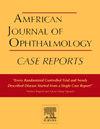A case of atypical retinopathy of prematurity with coexisting occlusive vasculitis
Q3 Medicine
引用次数: 0
Abstract
Purpose
To report an atypical case of retinopathy of prematurity (ROP) presenting with severe retinal vascular changes in a preterm infant who did not meet conventional criteria for aggressive ROP.
Observations
A male infant, born at 32 weeks and 6 days of gestation with a birth weight of 1400 g, developed significant retinal changes by 4 weeks of postnatal age. Fundus examination revealed bilateral severe plus disease, flat neovascularization, multiple retinal hemorrhages, severe vascular sheathing, extensive perivascular deposits, and arteriovenous shunting within zone I. These findings were atypical and resembled occlusive vasculitis, differing from classical aggressive ROP. During hospitalization, he received non-invasive oxygen therapy for 13 days, with oxygen saturation in the target range of 90–94 %. Although his general condition remained stable and there were no signs of infection, serum interleukin-6 levels were elevated at birth, suggesting possible perinatal inflammation. Intravitreal ranibizumab (0.2 mg) was administered on the day of diagnosis. Retinal vascular abnormalities gradually resolved over 4 weeks following treatment. No recurrence or complications were observed up to a postmenstrual age of 70 weeks.
Conclusions and importance
This case shows that severe and unusual retinal changes can develop even in premature infants who are not considered high risk for aggressive ROP based on gestational age or birth weight.
Fluctuations in oxygen levels and inflammation may play a role in these unusual forms of ROP, and further research is needed to better understand these causes.
早产儿非典型视网膜病变合并闭塞性血管炎1例
目的报告一例不符合常规标准的早产儿视网膜病变(ROP),其表现为严重的视网膜血管改变。一名出生在妊娠32周零6天、出生体重为1400克的男婴,在出生后4周时出现了明显的视网膜变化。眼底检查显示双侧严重病变,扁平新生血管,多发视网膜出血,严重血管鞘,广泛血管周围沉积物,i区动静脉分流。这些表现不典型,类似闭塞性血管炎,不同于典型的侵袭性ROP。住院期间,患者接受无创氧疗13天,血氧饱和度在目标范围90 - 94%。虽然他的一般情况保持稳定,没有感染的迹象,但出生时血清白细胞介素-6水平升高,提示可能是围产期炎症。诊断当日给予玻璃体内注射雷尼单抗(0.2 mg)。视网膜血管异常在治疗后4周内逐渐消退。经后70周未见复发或并发症。结论和重要性:本病例表明,即使在胎龄或出生体重不被认为是侵袭性ROP高风险的早产儿中,也可能发生严重和不寻常的视网膜病变。氧水平的波动和炎症可能在这些不寻常的ROP形式中起作用,需要进一步的研究来更好地了解这些原因。
本文章由计算机程序翻译,如有差异,请以英文原文为准。
求助全文
约1分钟内获得全文
求助全文
来源期刊

American Journal of Ophthalmology Case Reports
Medicine-Ophthalmology
CiteScore
2.40
自引率
0.00%
发文量
513
审稿时长
16 weeks
期刊介绍:
The American Journal of Ophthalmology Case Reports is a peer-reviewed, scientific publication that welcomes the submission of original, previously unpublished case report manuscripts directed to ophthalmologists and visual science specialists. The cases shall be challenging and stimulating but shall also be presented in an educational format to engage the readers as if they are working alongside with the caring clinician scientists to manage the patients. Submissions shall be clear, concise, and well-documented reports. Brief reports and case series submissions on specific themes are also very welcome.
 求助内容:
求助内容: 应助结果提醒方式:
应助结果提醒方式:


